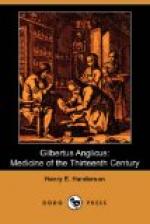Gunshot wounds were, of course, unknown in Gilbert’s day. In a chapter entitled “De craneo perforato” he gives us, however, the treatment of wounds of the head produced by the transfixion of that member by an arrow. If the arrow passes entirely through the head, and the results are not immediately fatal, he directs the surgeon to enlarge the wound of exit with a trephine, remove the arrowhead through this opening, and withdraw the shaft of the arrow through the wound of entrance. The wounds of the cranium are then to be treated like ordinary fractures of that organ (f. 88c).
In wounds of the neck involving the jugular vein (vena organica), Gilbert directs ligation of both extremities of the wounded vessel, after which the wound is to be dressed (but not packed) with the ordinary dressing of egg-albumen.
Wounds of nerves are treated with a novel dressing of earthworms lightly beaten in a mortar and mixed with warm oil, and he professes to have seen nerves not only healed (conglutinari), but even the divided nerve fibres regenerated (consolidari) under this treatment. In puncture of a nerve Gilbert surprises us (f. 179d) by the advice to divide completely the wounded nerve, in order to relieve pain and prevent tetanus (spasmus).
Goitre, not too vascular in character, is removed by a longitudinal incision over the tumor, after which the gland is to be dragged out, with its entire capsule, by means of a blunt hook. A large goitre in a feeble patient, however, is better left alone, as it is difficult to remove all the intricate roots of the tumor, and if any portion is left it is prone to return. In such cases Gilbert says we shrink from the application of the actual cautery, for fear of injury to the surrounding vessels and nerves. Whatever method of operation is selected, the patient is to be tied to a table and firmly held in position.
Wounds of the trachea and oesophagus, according to Gilbert, are invariably mortal.
In wounds of the thorax the ordinary dressing of albumen is to be applied, but if blood or pus enters the cavity of the thorax, the patient is directed to bend his body over a dish, twisting himself from one side to another (supra discum[10] flectat se modo hac modo ilac vergendo) until he expels the sanies through the wound, and to always lie with the wound dependent until it is completely healed (f. 182d).
[Footnote 10: It is interesting to observe how the Latin discus developed dichotomously into the English “dish” and the German “Tisch.” The former is doubtless the meaning of the word in this place.]
In case an arrow is lodged within the cavity of the thorax, the surgeon is directed to trepan the sternum (os pectoris), remove the head of the arrow gently from the shaft, and withdraw the shaft itself through the original wound of entrance. If the head is lodged beneath or between the ribs, an opening is to be made into the nearest intercostal space, the ribs forced apart by a suitable wedge and the head thus extracted. The wound through the soft parts is to be kept open by a tent greased with lard and provided with a suitable prolongation (cauda aliqua) to facilitate its extraction and prevent its falling into the cavity of the chest.




